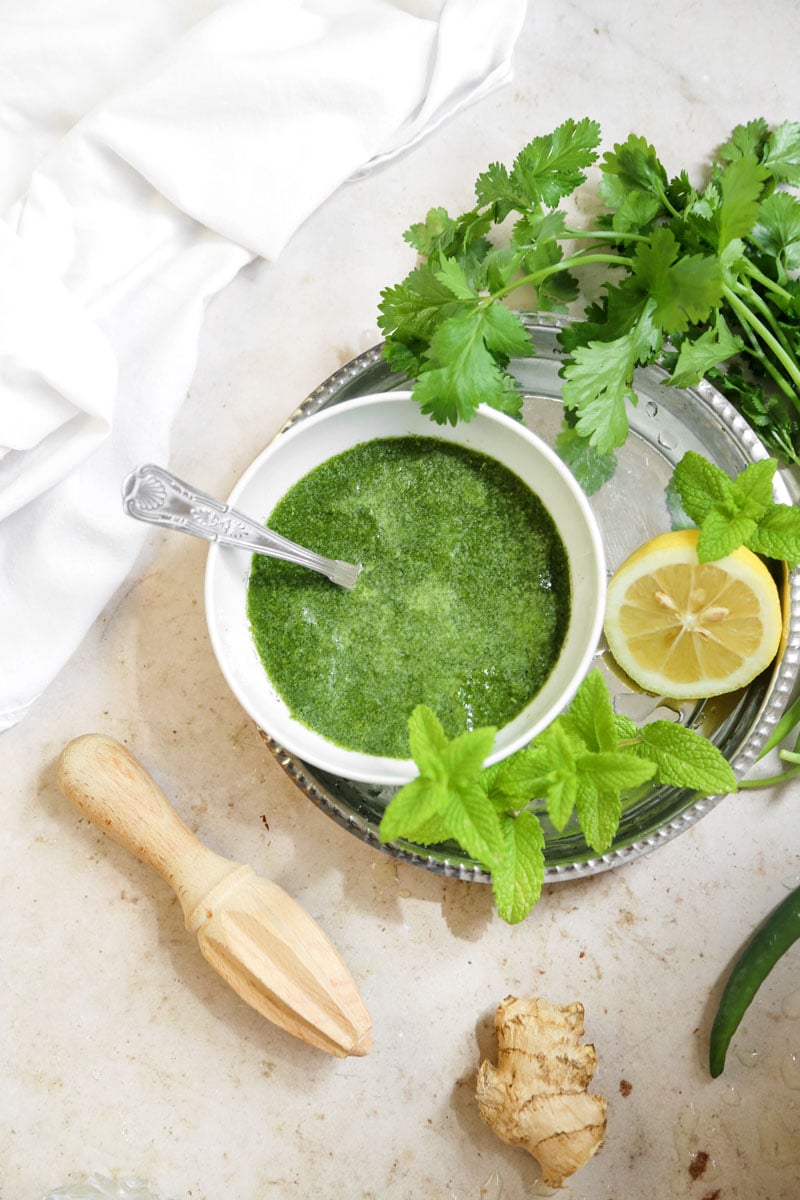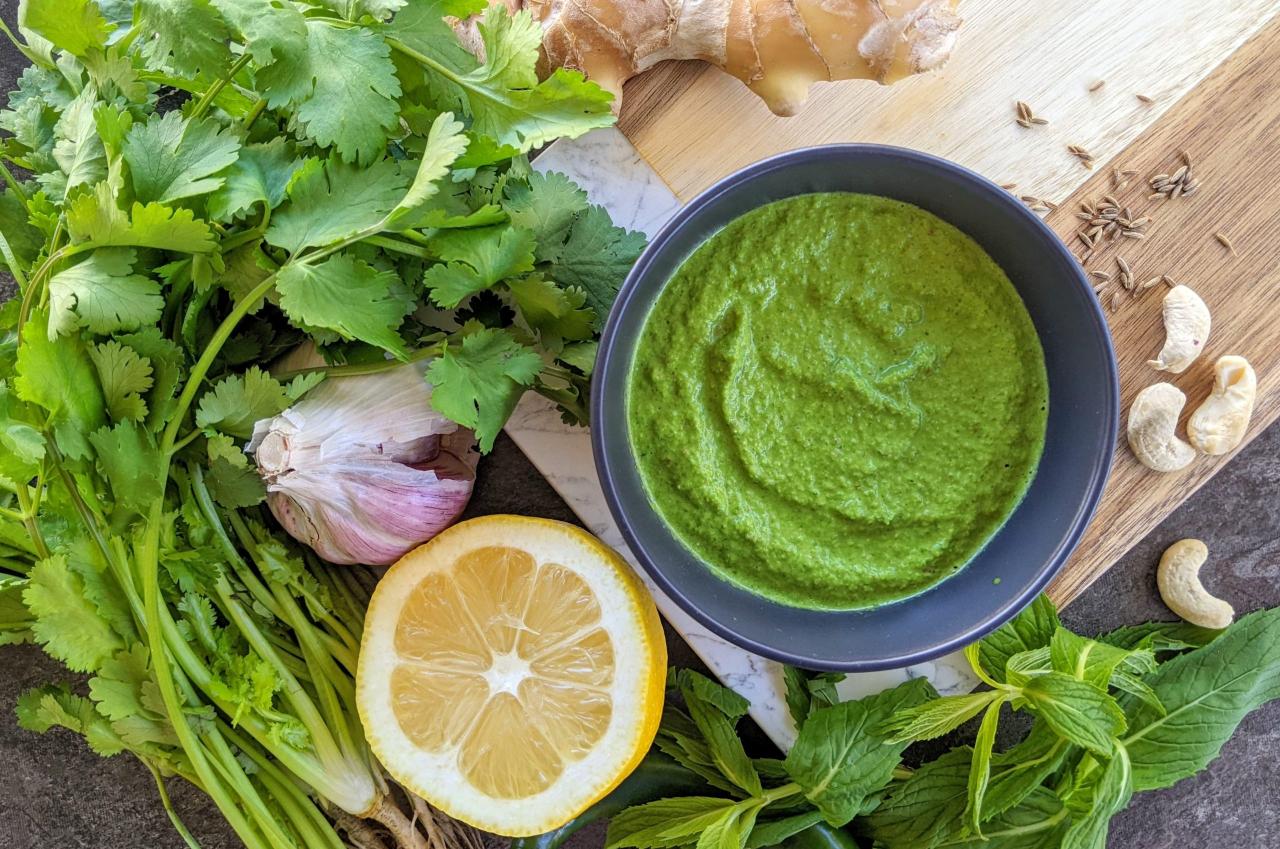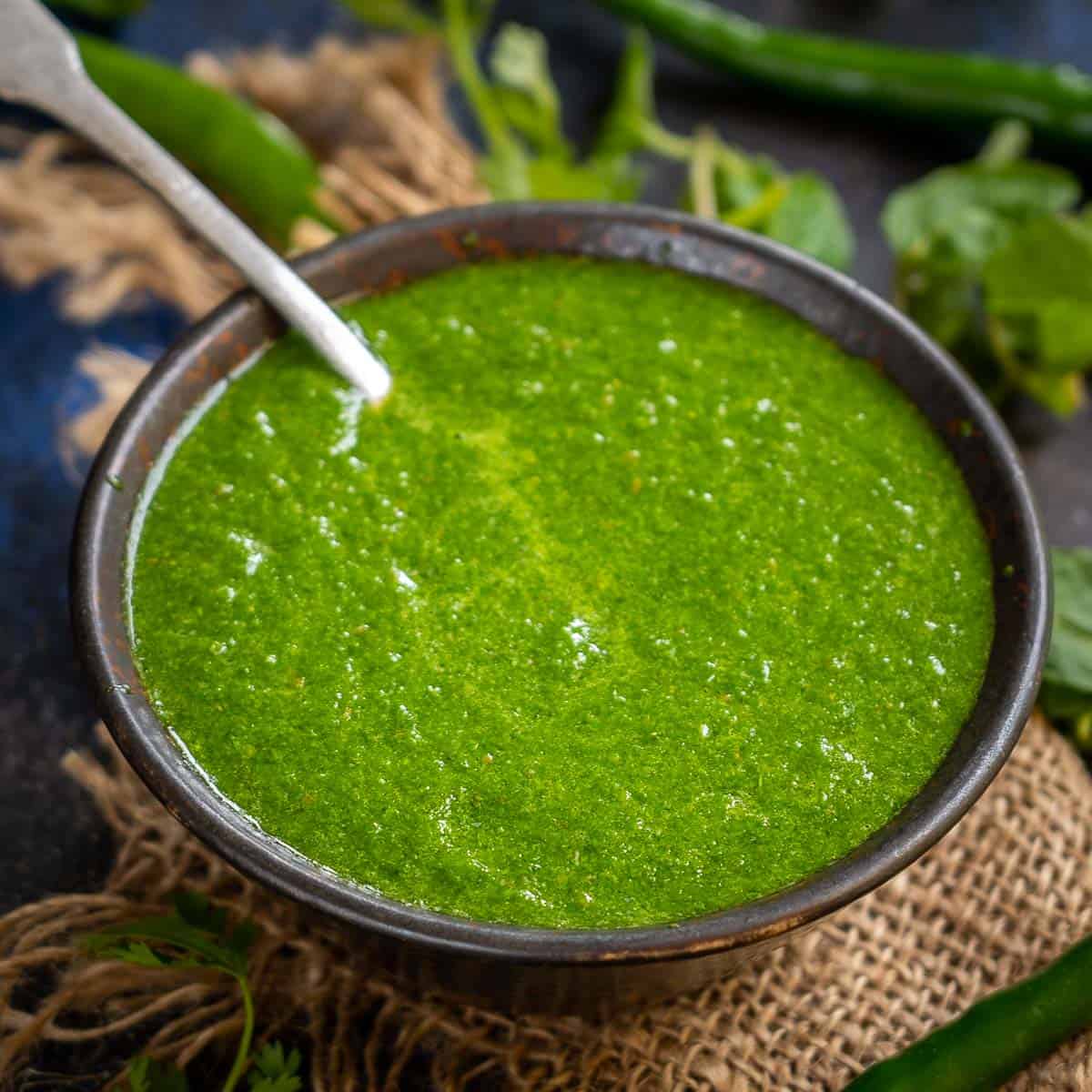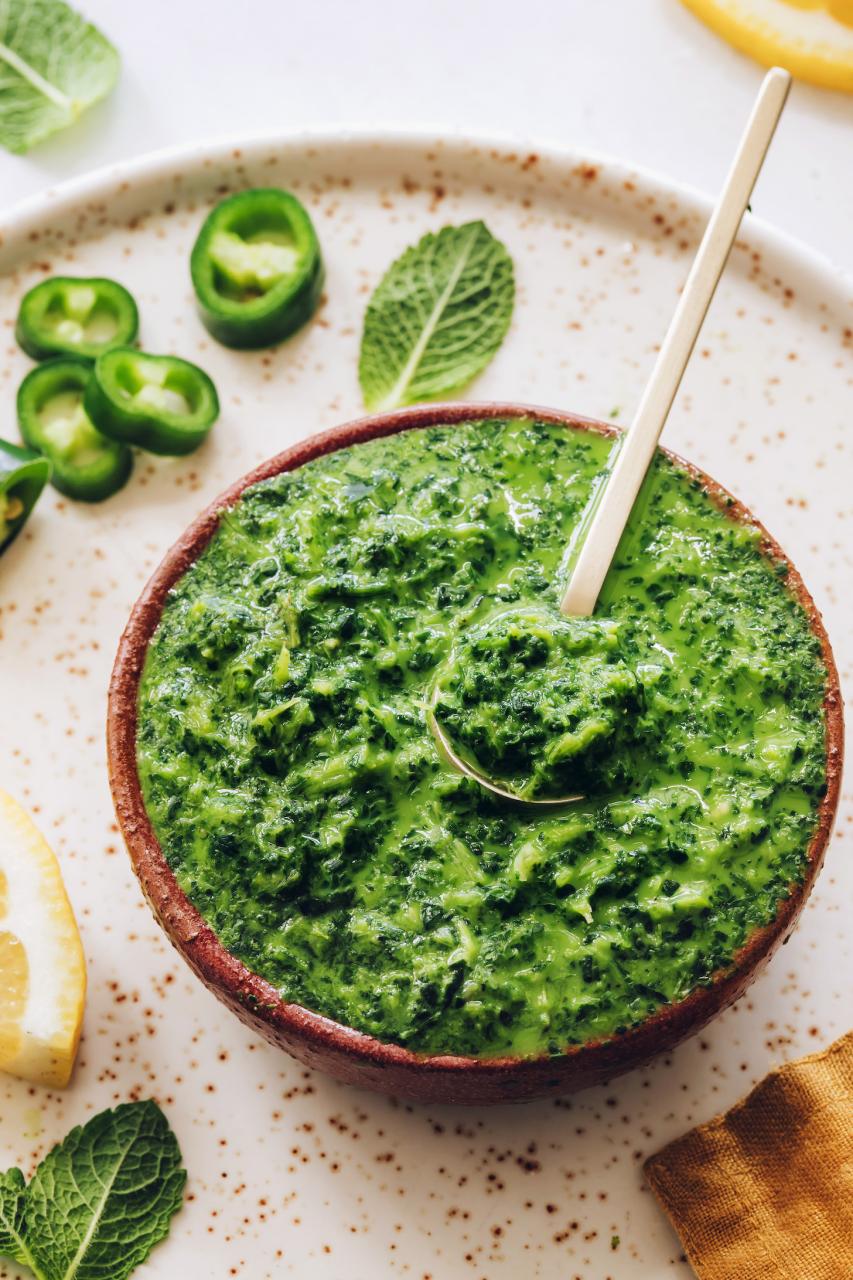Curry Leaf, Mint, and Cilantro Chutney is a vibrant and flavorful condiment that blends the fragrant trio of fresh curry leaves, mint, and cilantro—herbs that are staples in Indian cooking. This chutney is known for its herbal freshness, underlined by a zesty tang and aromatic warmth, making it a popular accompaniment in various regional cuisines across India.
The key ingredients harmonize to create a medley of flavors: the curry leaves offer a unique lemony and slightly nutty taste, mint is recognized for its cooling and refreshing quality, and cilantro (coriander leaves) adds a citrus-like depth. Together, they form a base that is not only delicious but also packed with health benefits, such as aiding digestion and serving as a source of essential vitamins and antioxidants.
Curry Leaf, Mint, and Cilantro Chutney Recipe


Curry Leaf, Mint, and Cilantro Chutney
Equipment
- 1 large skillet
Ingredients
- 1/2 cup curry leaves
- 20 fresh mint leaves
- 2 tablespoons roughly chopped fresh cilantro
- 2 tablespoons husked whole black lentils
- 2 tablespoons Bengal gram
- 3 dried Guntur chiles
- 1 marble-size seedless tamarind block
- 1/4 cup shredded fresh coconut or frozen, thawed to room temperature
- 11/4 teaspoons salt
- 3/4 cup water divided
- 1 teaspoon vegetable or corn oil
- 1 teaspoon mustard seeds
- 1/2 teaspoon asafoetida
Instructions
- Heat a large skillet over medium heat.
- Add the curry leaves, mint leaves, and cilantro. Dry-roast 4 to 5 minutes, until the curry leaves are crisp. Transfer to a plate and set aside.
- Return the skillet to medium heat and add the black lentils, Bengal gram, and Guntur chiles. Dry-roast for 3 to 4 minutes until the lentils turn light brown. Turn off the heat and add the tamarind to the hot pan so it softens a bit. Set aside to cool for about 10 minutes.
- Transfer the lentil mixture to a blender and pulse into a coarse powder.
- Add the curry leaves mixture, coconut, salt, and 1⁄2 cup of water and blend until a smooth paste forms. Transfer the paste to a medium bowl.
- Rinse the blender with the remaining 1⁄4 cup of water and add this to the bowl. Stir well to combine.
- Heat a small skillet over medium heat. Add the oil and heat for 30 seconds.
- Add the mustard seeds and asafoetida. Cook until the mustard seeds begin to sputter, about 1 minute, and turn off the heat.Stir this spice mixture into the chutney until mixed well.
Notes
your preference. If you use more mint, sauté it until it no longer smells raw.
Cooking Tips about Curry Leaf, Mint, and Cilantro Chutney

- Use Fresh Herbs: For the best flavor, ensure that curry leaves, cilantro (coriander), and mint are fresh and green. Wilted or dry herbs will not yield the same vibrant taste.
- Proper Cleaning: Wash all the herbs thoroughly in water to remove any dirt or pesticides. You can soak them in water with a little vinegar before rinsing.
- Balanced Ratios: Balance the quantities of cilantro, mint, and curry leaves to your taste. Generally, cilantro forms the bulk of the chutney.
- Managing Spice: Adjust green chili quantity according to your preferred level of heat. Removing the seeds can also mitigate some of the spiciness.
- Tangyness: Add a sour element such as tamarind paste or lemon/lime juice to give the chutney an acidic note which complements the herbs’ flavors.
- Adding Sweetness: To counterbalance the heat and acidity, a small amount of sugar or jaggery can be blended into the chutney.
- Salt to Taste: Season with salt cautiously. It’s easier to add more later than to correct an overly salty chutney.
- For Thickness and Creaminess: Some recipes include grated coconut or roasted gram dal (dalia) which adds body and creaminess to the chutney. Yogurt is also sometimes included to create a creamier texture.
- Tempering (Tadka): A final tempering of mustard seeds, dried red chilies, asafoetida (hing), and urad dal fried in oil can be poured over the chutney to add another layer of flavor.
- Use of Water: Be conservative with water when grinding the chutney; you can always add more to reach the preferred consistency.
Serving suggestions about Curry Leaf, Mint, and Cilantro Chutney

- With South Indian Breakfasts: Ideal when served with dosas, idlis, and vadas. The freshness complements these savory breakfast items perfectly.
- As a Sandwich Spread: Spread it on sandwiches for an herbal kick. Works great with cucumber or tomato slices.
- With Grilled Foods: Pair it with grilled chicken or fish, applying it as a coating before grilling, or using it as a post-grill topping for an extra burst of flavor.
- Dip for Snacks: Serve it alongside savory snacks like pakoras, samosas, and chips for dipping.
- Chapati or Paratha Roll: Use it as a base for making rolls with chapatis or parathas, adding vegetables and grilled paneer or kebabs.
- In Salads: A spoonful of chutney can also jazz up a plain salad or be used in the dressing.
- Topping for Appetizers: Top off canapés or crackers with a small dollop of chutney for an elegant appetizer.
- Marinade for Proteins: Use it to marinate meats or tofu. The herbs and spices penetrate for a flavorful result.
- With Rice Dishes: Accompany rice-based dishes with the chutney, especially those that could use a fresh herbal element.
- Yogurt Mix-in: Stir into plain yogurt to create a flavorful raita to accompany spicy dishes.
Top 5 FAQs about Curry Leaf, Mint, and Cilantro Chutney

- What are the key ingredients for Curry Leaf, Mint, and Cilantro Chutney? The key ingredients include fresh curry leaves, cilantro (coriander leaves), mint leaves, green chilies, tamarind or lime juice for acidity, and sometimes grated coconut for texture. Spices like cumin and mustard seeds can be added for more depth.
- How do I prepare Curry Leaf, Mint, and Cilantro Chutney? To prepare the chutney, wash and clean the leaves. Blend the herbs, green chilies, and other spices together in a food processor. Add lime juice or tamarind for tanginess and salt to taste. For creaminess, include some grated coconut if desired. You can do a tempering (tadka) with mustard seeds and curry leaves in hot oil and mix it into the chutney after blending for an extra flavor boost.
- Can I store Curry Leaf, Mint, and Cilantro Chutney, and how long does it last? Yes, you can store it in an airtight container in the refrigerator for a few days. However, since it contains fresh herbs, it’s best consumed within 2-3 days for optimal flavor.
- Is Curry Leaf, Mint, and Cilantro Chutney spicy? The spice level depends on the amount and type of green chilies used. Adjust the quantity to make it milder or hotter to your liking. Removing seeds from chilies can also help manage the heat.
- What can I serve with Curry Leaf, Mint, and Cilantro Chutney? This chutney is versatile and goes well with South Indian breakfast items such as dosas and idlis, works great as a spread in sandwiches or wraps, pairs with grilled meats and veggies, and can be used as a dip for snacks like pakoras or samosas.
Curry Leaf, Mint, and Cilantro Chutney, also popularly known as Kothamalli Pudina Chutney, is not just a condiment but a burst of flavors that bring to life any meal it accompanies. Its vibrant green color and the aromatic profile is a sensory delight evocative of the complexities and the richness of Indian cuisine.

Leave a Reply